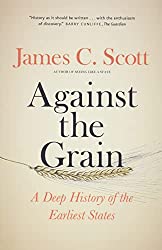
Rating: 7.5/10.
Against the Grain: A Deep History of the Earliest States by James C. Scott
Book about the neolithic revolution and how early states arose out of hunter-gatherers. The traditional narrative is that the invention of agriculture enabled the formation of larger, more complex states, and this is the first step on the road of humanity’s progress. However, this book examines evidence from early societies (especially Mesopotamia) and argues that this was not the case: life in agrarian states was much worse than in hunter-gatherer societies, as measured by lifespan, health, and diet, and states should be viewed as a “domestication of the human” for the purposes of the ruling class.
Hunter-gatherers practiced agriculture thousands of years before the earliest states, and their diet consisted of a mixture of gathering and farming. The agrarian diet provided more calories than that of the hunter-gatherers, but was more fragile, less varied, and required more work. The earliest states arose from wetland regions where grains (wheat, rice, barley, etc) can be produced. What makes grains unique was its ability to be collected as tax, since they must be harvested at a specific time of year, and can be stored for a long time. Other crops such as potatoes, which are harvested year-round are much less convenient for tax collection, as state cannot collect a year’s tax at once. The first writing was also invented to keep track of tax collection.
Another function of the early state was to keep its population inside. Many states were reliant on slave labor, which they obtained by raiding nearby populations. Early states are fragile and can collapse due to short-term factors like disease or invasion, or long-term factors such as environmental degradation causing crop failures. These “collapses” were not disasters for most people, but rather a liberation where they no longer have to pay taxes to a central authority and return to their previous hunter-gatherer freedom; the term “dark age” means merely a lack of written records after state collapse and not a degradation of quality-of-life. Life was good for barbarians outside early states, since they were able to raid the state’s grain stores, reaping the benefits without all the costs, and the state’s armies were mostly helpless against the raids; they often had to pay large amounts of tribute to barbarians in return for not being raided.
Overall, this book presents a simple narrative for statehood in the neolithic revolution, one that is attractive to many with libertarians views, but is probably oversimplified. Much of it is not too novel, and I’ve seen the downside of agriculture explained in other works such as the novel “Ishmael” and books by Yuval Harari. The author does not cover any alternative viewpoints on this highly-debated topic; there is not much details on life and social structure in hunter-gatherer societies, and the author just assumes they are better.



